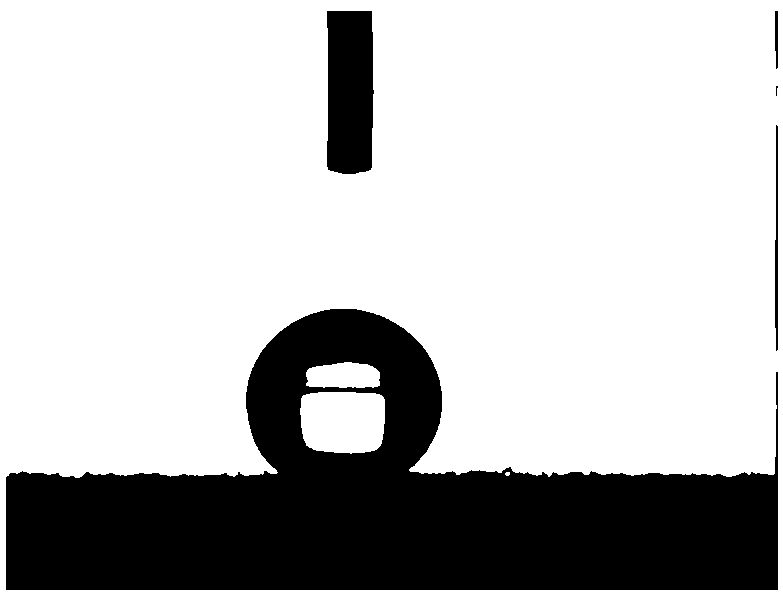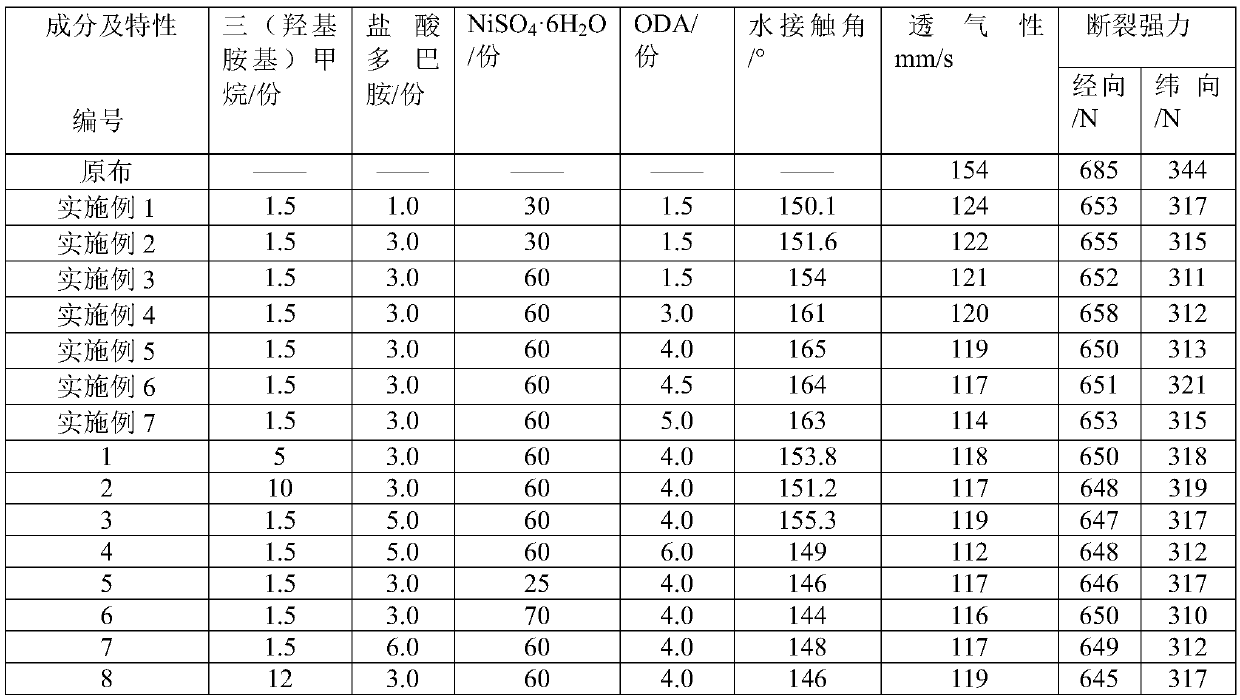Wearing-resistant super-hydrophobic fabric and preparation method thereof
A super-hydrophobic, fabric technology, applied in plant fibers, textiles and papermaking, ultrasonic/sonic fiber processing, etc., can solve the problems of complex preparation process of super-hydrophobic surface, incapable of industrial production and application, poor wear resistance of super-hydrophobic fabrics, etc. To achieve the effect of convenient and fast preparation process, small loss of breaking strength and strong superhydrophobicity
- Summary
- Abstract
- Description
- Claims
- Application Information
AI Technical Summary
Problems solved by technology
Method used
Image
Examples
Embodiment 1
[0047] ①At room temperature, take 1.5 parts of tris(hydroxylamino)methane in a beaker, add deionized water to a total weight of 1000 parts, then add 1.0 parts of dopamine hydrochloride, stir with a magnetic stirrer until completely dissolved, and then add 2.0M hydrochloric acid Adjust its pH to 8.5.
[0048] ②Take 30 parts of NiSO 4 ·6H 2 O in a beaker, add deionized water to a total weight of 100 parts, then stir with a magnetic stirrer until completely dissolved.
[0049] ③Take 0.15 parts of NaOH in a beaker, add deionized water to a total weight of 300 parts, and then stir with a magnetic stirrer until completely dissolved.
[0050] ④ Take 1.5 parts of ODA in a beaker, add absolute ethanol to a total weight of 110 parts, then place the beaker in a constant temperature water bath at 60°C and heat until ODA is completely dissolved.
[0051] ⑤ Under the stirring of a magnetic stirrer, soak the clean raw cotton fabric in the dopamine buffer for 35 minutes, take it out, first...
Embodiment 2
[0056] ①At room temperature, take 1.5 parts of tris(hydroxylamino)methane in a beaker, add deionized water to a total weight of 1000 parts, then add 3.0 parts of dopamine hydrochloride, stir with a magnetic stirrer until completely dissolved, and then add 2.0M hydrochloric acid Adjust its pH to 8.5.
[0057] ②Take 30 parts of NiSO 4 ·6H 2 O in a beaker, add deionized water to a total weight of 100 parts, then stir with a magnetic stirrer until completely dissolved.
[0058] ③Take 0.15 parts of NaOH in a beaker, add deionized water to a total weight of 300 parts, and then stir with a magnetic stirrer until completely dissolved.
[0059] ④ Take 1.5 parts of ODA in a beaker, add absolute ethanol to a total weight of 110 parts, then place the beaker in a constant temperature water bath at 60°C and heat until ODA is completely dissolved.
[0060] ⑤ Under the stirring of a magnetic stirrer, soak the clean raw cotton fabric in the dopamine buffer for 35 minutes, take it out, first...
Embodiment 3
[0066] ①At room temperature, take 1.5 parts of tris(hydroxylamino)methane in a beaker, add deionized water to a total weight of 1000 parts, then add 3.0 parts of dopamine hydrochloride, stir with a magnetic stirrer until completely dissolved, and then add 2.0M hydrochloric acid Adjust its pH to 8.5.
[0067] ②Take 60 parts of NiSO 4 ·6H 2 O in a beaker, add deionized water to a total weight of 100 parts, then stir with a magnetic stirrer until completely dissolved.
[0068] ③Take 0.15 parts of NaOH in a beaker, add deionized water to a total weight of 300 parts, and then stir with a magnetic stirrer until completely dissolved.
[0069] ④ Take 1.5 parts of ODA in a beaker, add absolute ethanol to a total weight of 110 parts, then place the beaker in a constant temperature water bath at 60°C and heat until ODA is completely dissolved.
[0070] ⑤ Under the stirring of a magnetic stirrer, soak the clean raw cotton fabric in the dopamine buffer for 35 minutes, take it out, first...
PUM
| Property | Measurement | Unit |
|---|---|---|
| Contact angle | aaaaa | aaaaa |
| Longitudinal breaking strength | aaaaa | aaaaa |
| Weft breaking strength | aaaaa | aaaaa |
Abstract
Description
Claims
Application Information
 Login to View More
Login to View More - R&D
- Intellectual Property
- Life Sciences
- Materials
- Tech Scout
- Unparalleled Data Quality
- Higher Quality Content
- 60% Fewer Hallucinations
Browse by: Latest US Patents, China's latest patents, Technical Efficacy Thesaurus, Application Domain, Technology Topic, Popular Technical Reports.
© 2025 PatSnap. All rights reserved.Legal|Privacy policy|Modern Slavery Act Transparency Statement|Sitemap|About US| Contact US: help@patsnap.com



